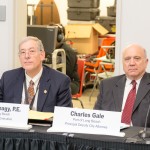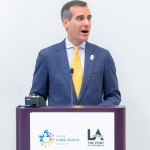Aggressively deploying zero and near-zero emission trucks and cargo-handling equipment and expanding programs that reduce ship emissions are among the core strategies the ports of Los Angeles and Long Beach are proposing for the next version of San Pedro Bay Ports Clean Air Action Plan (CAAP).
Proposals also focus on freight infrastructure investment, innovation and technology to improve supply chain efficiency, comprehensive energy planning, and increased advocacy for stricter emissions standards and government incentives to help pay for projects that advance testing and commercialization of zero and near-zero emission vehicles. The updated CAAP provides one of California’s first opportunities to implement the vision laid out in the State’s Sustainable Freight Action Plan.

Joint meeting of the Harbor Commissions of the Port of Long Beach and Port of Los Angeles on the Clean Air Action Plan.
Port officials met Thursday (watch the entire meeting here) to mark the 10th anniversary of the landmark initiative and unveil the CAAP 2017 Discussion Document, which outlines new concepts under consideration for the third iteration of the CAAP. Building on the unprecedented success of the earlier plans, the working document contains the boldest measures yet for moving the San Pedro Bay ports toward their ultimate goal of eliminating all harmful air pollution from port-related sources.
“The Ports of Los Angeles and Long Beach are driving forces of our region’s economy — they should also be models for how we move toward a more sustainable future by balancing growth and environmental stewardship,” said Los Angeles Mayor Eric Garcetti. “The draft Clean Air Action Plan is an important step in our work to reduce air pollution in our communities, and take action on climate change. I look forward to working with Mayor Garcia to build on this progress and continue strengthening this plan in the coming months.”
“These updates will move the region closer to a zero emissions future,” said Long Beach Mayor Robert Garcia. “We have already proven that it’s possible to increase jobs and trade with cleaner air and healthier communities and I want to thank all of our partners who helped make this possible.”
The Discussion Document prioritizes reducing greenhouse gas (GHG) emissions from port-related sources 80 percent below 1990 levels by 2050. The target aligns with California’s clean air goals and objectives in the state’s new Sustainable Freight Action Plan, as well as efforts by the cities of Los Angeles and Long Beach to shrink GHG emissions ahead of state targets. Cutting GHG emissions also helps the ports maintain and increase their dramatic progress in reducing other key pollutants, namely diesel particulate matter (DPM), nitrogen oxides (NOx) and sulfur oxides (SOx).
The joint meeting kicked off a three-month public review and comment period that extends through Feb. 17, 2017. The ports plan to incorporate public comments received and present the 2017 CAAP Update for final consideration by their governing boards in spring 2017 at another joint harbor commission meeting.
Developed with input from industry, government, community and environmental stakeholders, the Discussion Document recommends a new suite of incentives, lease requirements and regulatory approaches to achieve CAAP goals. They include the following near- and long-term proposals grouped under the categories below:
Clean Vehicles, Equipment Technology and Fuels:
- Phase in clean engine standards for port trucks and offer preferential terminal access to green trucks, to transition to a zero emission drayage fleet by 2035.
- Reduce idling and transition to zero emission yard equipment by 2030.
- Update the Vessel Speed Reduction Program, expand the use of state-approved alternative technologies to reduce at-berth emissions, incentivize clean technology upgrades on ships, and encourage carriers to deploy their cleanest vessels to the San Pedro Bay ports.
- Accelerate deployment of cleaner harbor craft engines.
Freight Infrastructure Investment and Planning:
- Expand use of on-dock rail by investing in improvements to the port-wide rail network, with the long-term goal of moving 50 percent of all inbound cargo leaving the ports by rail.
- Develop charging standards for electric cargo-handling equipment.
Freight Efficiency:
- Create a voluntary Green Terminal Program to recognize terminal operators achieving high levels of freight movement efficiency.
- Continue to explore short-haul rail, staging yards, truck appointment systems, off-terminal queuing, intelligent transportation systems and other strategies for enhancing efficiencies across the supply chain.
Energy Resource Planning:
- Develop infrastructure plans to support terminal equipment electrification, alternative fuels and other energy resource goals.
- Continue to develop and implement viable energy conservation, resiliency and management strategies under the Port of Los Angeles Energy Action Management Plan and the Port of Long Beach Energy Initiative.
CAAP 2017 improves upon the initial plan adopted in 2006 and updated in 2010 to reduce emissions from all port-related sources: ships, trucks, trains, cargo-handling and smaller harbor craft, such as tugboats. One original strategy whose importance has increased over time is the Technology Advancement Program (TAP), created to accelerate the development and demonstration of cutting-edge emission reduction technology.
To date, the ports have invested $15 million in 35 TAP projects. TAP successes include emission capture systems for ships at berth, hybrid-electric rubber tire gantry cranes, and drayage trucks and yard tractors fueled by liquefied natural gas, which are all now commercially available. The investment to date includes funding for zero and near-zero emission truck and yard tractor demonstration projects already in progress.
Under the CAAP, the ports of Los Angeles and Long Beach have reduced DPM up to 85 percent, cut NOx in half, eliminated 97 percent of SOx, and lowered GHG an average of 12 percent, all while container volume has increased by 7 percent. The results reflect the ports’ combined clean air progress in collaboration with industry, regulatory, community and environmental partners since 2005. The findings also show the ports continue to exceed their 2023 targets for reducing DPM and SOx (77 percent and 93 percent respectively) and are closing in on their 2023 target of reducing NOx emissions 59 percent.
At Thursday’s meeting, port leaders welcomed all members of the port community to weigh in on the Discussion Document.
“We’ve made undeniable gains in improving air quality over the last 10 years,” said Lori Ann Guzmán, president of the Long Beach Board of Harbor Commissioners. “We thank our partners in the goods movement industry for their contributions, and we’re looking forward to public input to make this the best update possible.”
“There is still a lot of work to do and getting across the finish line will not be easy or inexpensive,” added Ambassador Vilma Martinez, President of the Los Angeles Harbor Commission. “Partnerships and cooperation among all stakeholders will be critical to success, as will be the financial participation from both the public and private sectors.”
The Discussion Document is available at www.polb.com, www.portoflosangeles.org and www.cleanairactionplan.org. During the review period, the ports will hold additional community meetings to gather public comment on the Discussion Document.
Written comments may be submitted to [email protected] at any time during the review period. Interested parties are encouraged to register on the CAAP website to receive the latest information and meeting notices.









